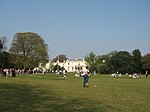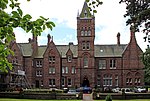Strawberry Field

Strawberry Field is a Salvation Army property and visitor attraction in the Liverpool suburb of Woolton. It operated as a children's home between 1936 and 2005. The house and grounds had originally been built as a private residence in the Victorian era, before being acquired by the Salvation Army in the 1930s. The house was demolished in 1973 due to structural problems and replaced with purpose-built units. After being closed as a children's home, the site has continued to be used by the Salvation Army for other purposes. The location gained worldwide fame following the release of the Beatles' 1967 single "Strawberry Fields Forever". The song's writer, John Lennon, had grown up nearby and played in the grounds of the home as a child. In time, the old red-painted entrance gates on Beaconsfield Road became a place of pilgrimage for Beatles fans. In 2019, Strawberry Field was opened to the public for the first time, with an exhibition on its history, cafe, and shop, alongside a training centre for young people with special educational needs. The gates were stolen on 11 May 2000, allegedly by two men in a transit van. The gates were sold to an unsuspecting antiques dealer who never realised they were the actual gates from Strawberry Field. He returned them to the police upon request, and they now stand in the grounds of Strawberry Field.
Excerpt from the Wikipedia article Strawberry Field (License: CC BY-SA 3.0, Authors, Images).Strawberry Field
Beaconsfield Road, Liverpool Woolton
Geographical coordinates (GPS) Address Phone number Nearby Places Show on map
Geographical coordinates (GPS)
| Latitude | Longitude |
|---|---|
| N 53.380277777778 ° | E -2.8838888888889 ° |
Address
Abbot's Lea School
Beaconsfield Road
L25 6EE Liverpool, Woolton
England, United Kingdom
Open on Google Maps







